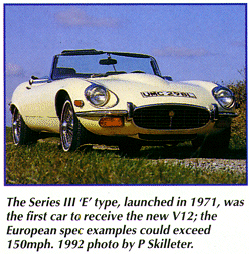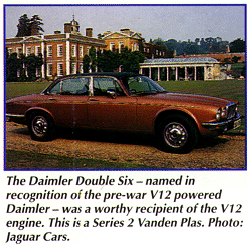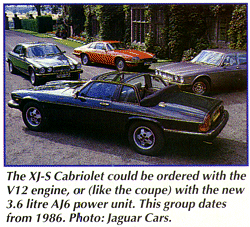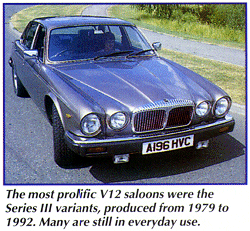|
|
 |
[ Main ] [ 1 ] [ 2 ]
[ 3 ] [ 4 ] [ 5 ] [ 6 ] [ 7 ] [ 8 ] [ 9 ] [ 10 ] [ 11 ] |
Fuel injection or carburetters?Having decided on the flat head route back in the late 1960s the Jaguar team then had to decide what sort of fuel system should be used. The embryonic AE Brico electronic fuel injection system showed great promise and on the V12 gave a substantial power advantage over carburetters yet, strange as it now seems, was perceived as being more of a challenge than carbs to be able to satisfy impending legislation regarding exhaust emissions. Jaguar never had to decide between the two because the Brico board of directors, faced with a longer than expected development program, got cold feet and scrapped the project. Aston Martins DB6 and Ferraris 246 Dino were also left in the lurch by this decision. So now there was no choice, the V12 had to have carburetters - two to each bank on overhung manifolds (Fig. 2) to obtain a reasonable ram length for maintaining torque (ideally, had there been space, still more ram length would have been beneficial). The overhung manifold design had one very serious drawback - cold starting required vast overfuelling just to get enough combustible mixture up over the cam covers for firing up, earning the V12 the dubious honour of being the first UK home market engine to need air injection into the exhaust ports to burn off the excess fuel. Really, when one looks at a carburetter V12 it is hard to imagine that it was anything other than a stop-gap measure until a suitable EFI system became available. It has been suggested that if suitable downdraft carbs had been available they would have been used, but this must be doubtful if only because of the existing location of the distributor and spark plugs, and in any event the individual tracts would have been far too short for any useful ram effect. The team responsible were respected and experienced engineers and would surely not have compromised the installation of carburetters by placing the distributor and plugs in the centre of the vee unless they envisaged only using fuel injection from the outset.Fortunately the same original work by Bendix on which the Brico system was based had already spawned the Bosch D Jetronic system which had been used successfully by Mercedes, VW and one or two others, so it was arranged that Lucas would develop a version of it to suit the V12. In fact the two systems only differed in detail except that D Jetronic could not drive 12 injectors. This was easily resolved by the addition of an amplifier which also changed the polarity of the drive circuit to take injector current to ground as is now accepted practice. The inlet manifolds and throttle assemblies (Fig. 2) designed for the original Brico engines were not a lot different even to those found on the last V12 to be built. A curious early feature was that the throttles were aerodynamically shaped castings mounted on a solid spindle, but they were soon replaced by conventional throttle discs in slotted spindles. It is interesting that despite virtually all other EFI Jaguar engines using airflow meters of one sort or another to measure engine load, all injected production V12s from the very first to the last relied on manifold pressure measurement. By the time the EFI V12 was launched in 1975 it was clear that V12s with carbs were never going to meet ever tighter US emission standards because of the poor cold start performance. Of course D Jetronic was not sophisticated enough to run with Lambda (exhaust oxygen) sensors as modern systems do so these early emission V12s with low (7.8:1) compression ran with oxidising catalysts and air pumps just as carburetter engines had done. NOx emissions were dealt with by incorporating solenoid operated EGR (exhaust gas recirculation, an established method) valves into the EFI system mounted under the throttles, bringing the unexpected problem of exhaust noise being clearly audible from the air intakes, cured by relocating the EGR take off points. Performance of these engines, as with all emission engines of the period, was very stunted compared to the 9:1 compression European version which was very much better than the carburetter engines. The engine itself did not change at this time so the advantage of EFI, which should have been there right from the start, was very clear. |

|
| [ Main ] [ 1 ] [ 2 ] [ 3 ] [ 4 ] [ 5 ] [ 6 ] [ 7 ] [ 8 ] [ 9 ] [ 10 ] [ 11 ] |
Email aj6engineering@ntlworld.com, Tel/Fax:- 0044 (0)1625 573556 |



